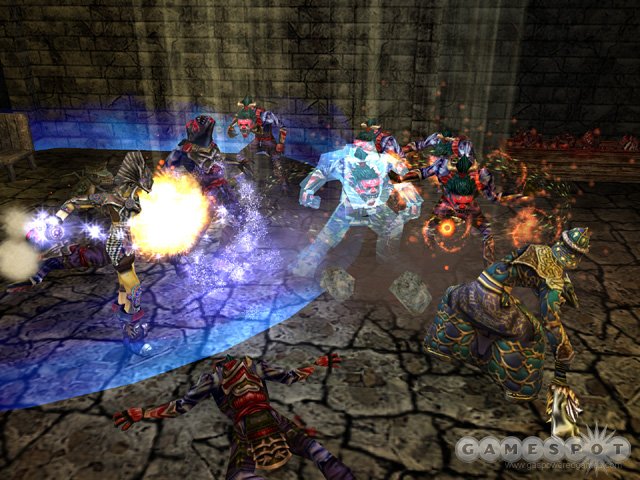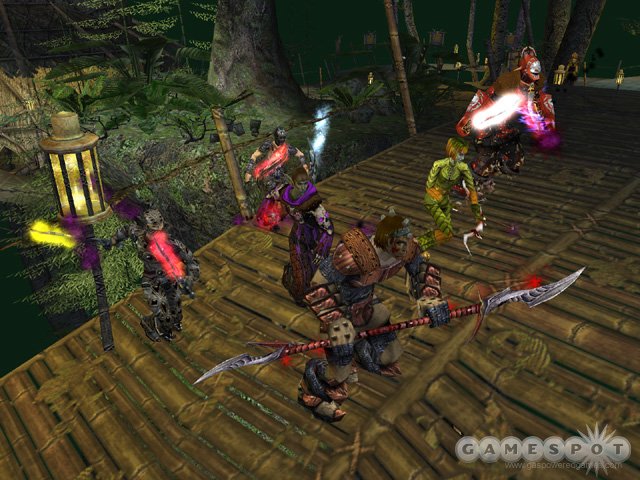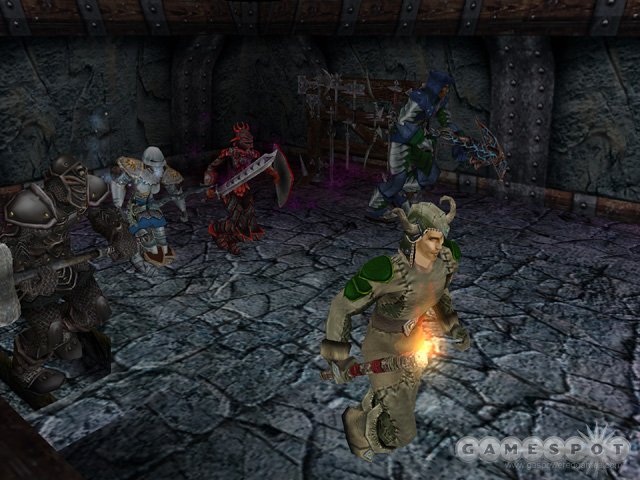Dungeon Siege II Updated Q&A - Single-Player
Lead designer Kevin Lambert tells us about the many new features to be found in the single-player campaign.
The original Dungeon Siege embodied the action role-playing genre. A fast-paced, hack-and-slash game, Dungeon Siege let you control a party of adventurers as they cut their way through hordes of monsters in the quest for loot, fame, and the defeat of the evil menace at the end. Now Microsoft and developer Gas Powered Games are working on the sequel, due out in the first part of next year. Dungeon Siege II will update the graphics and technology of the original game, but there will also be a much larger focus on creating a better single-player campaign as well. We caught up with lead designer Kevin Lambert for some details.

GameSpot: We've been told on previous occasions that the most common feedback that Dungeon Siege fans sent to the team was about the first game's story and setting, and that the team is really trying to create a story-driven single-player component for Dungeon Siege II. Without spoiling too much, can you tell us about the game's story and how it came about?
Kevin Lambert: Not only did we want to create a more compelling narrative experience for Dungeon Siege II, but we also wanted to make sure that the party characters were interesting and had flavorful personalities that came across during the adventure. To that end, the party characters will often speak and banter between each other depending on who is in your party. Dungeon Siege II takes place about 100 years after the original Dungeon Siege. [It still takes place] on the continent of Aranna, and we wanted to make the story much more epic in scope by having the player travel to many more locations across the continent this time around.
GS: How will the story tie into the single-player gameplay? What effects will the game's primary characters and their actions have on the game? Will we see branching paths that open and close to players depending on their decisions and how they completed certain quests?
KL: The primary quest arc is directly tied to the storyline. The plot will be thrust forward with the completion of each primary quest while the secondary quest arc will add depth to the world that players can feel free to explore or not. Players will occasionally come across some branching quest paths that will be slightly different depending on players' choices. The party characters all have their own personalities, histories, and personal agendas outside of the main adventure. If players pay close attention to what the party members have to say, they may uncover clues on how to embark on each party member's personal journey.

GS: How will the single-player game be structured? Will it be segmented into specific "chapters," or will the game take place in a single, continuous world? Will the single-player game tie into the multiplayer game in any way (such as carrying over characters, experience, or items), or vice versa?
KL: Even though the story is broken up into three acts, the single-player game takes place in a continuous world where players can return to any location they have visited at any time. Players can also replay any previously completed quest if they'd like a little more experience, more loot, or just for fun. In multiplayer, players can play cooperatively together through the single-player storyline either in "classic mode," as seen in the original Dungeon Siege (with just their main hero), or with each player bringing in multiple party characters. Players will also be able to export their single-player parties (including all characters, experience, and items) into multiplayer games.
Dual-Wielding Swordsmen
GS: Tell us about the quest system. We recall that the original game had a very traditional quest system that involved getting tasks from non-player characters, which are then noted in a journal. Will quests change in structure or execution from the original game? What effect will quests have on the game's larger story, and can we expect to see lots of optional side quests? 
KL: The quest system itself will be very recognizable to role-playing fans, and Dungeon Siege II has almost three times as many quests as the original Dungeon Siege's single-player campaign, including plenty of side quests that are much more involved than simply killing monsters. The Dungeon Siege II journal has been considerably beefed up in terms of listing all the quests, maps, lore, monsters, and handbook entries that are available in the game. This makes it easy for players to determine if they've missed something, and they can take a detour from the main storyline at any time to search for it if so desired.
GS: Tell us about the game's character creation and development systems. The original game let you play only as a human. Can we expect something similar in the sequel? Can we expect to see new races with new starting abilities?
KL: In Dungeon Siege II, players can choose to play as a human, elf, dryad, or half-giant, each with their own strengths and weaknesses that help differentiate them from one another.
GS: In the original game, players would choose from three primary skill sets to play their character--melee, archery, and magic (with several schools of magic to choose from)--and these skills simply increased over time with use. That had the effect of favoring characters that specialized in one certain skill type. How will character development and advancement be different and improved in the sequel? Will players not only grow stronger and wealthier, but also develop a reputation as an "evil" or "good" character?
KL: We brought back the same four character classes in Dungeon Siege II: melee, ranged, nature magic, and combat magic, but we added a lot more depth to each class in the form of skill trees and powers. Whereas in Dungeon Siege every character of the same class was identical, in Dungeon Siege II, depending on the skills you choose, characters can fall into different roles. For example, ranged characters might specialize in bows and crossbows or in thrown weapons, and melee characters might specialize in one-handed weapons and shields, two-handed weapons, or dual-wielding. Players will occasionally be given branching choices that can change the outcome of quests, but players don't have to worry about missing out on important parts of the game based on those choices or on reputation.
GS: Tell us about the game's characters. We recall that in the original game, you started out as a farmhand that ended up with a war party of followers who joined you at various points in the game. Will party members also be flexible, easygoing mercenaries who will all join your party, or will they be more or less inclined to join based on your reputation? Will there be "good" and "evil" follower characters?

KL: I wouldn't want to spoil too much of the story, but I can tell you that in Dungeon Siege II your main hero starts out as a mercenary fighting for the army of Valdis, a powerful tyrant who pays well but whose methods are often perceived as questionable. Over time, your character will decide what is right, what is wrong, and will eventually lead an elite battle party made up of characters of different races who all eventually share a common goal. Party members don't all necessarily offer to join right when you meet them, and you may have to prove yourself or do a few things before some party members will see you as a worthwhile companion.
GS: Thanks, Kevin.
Got a news tip or want to contact us directly? Email news@gamespot.com
Join the conversation